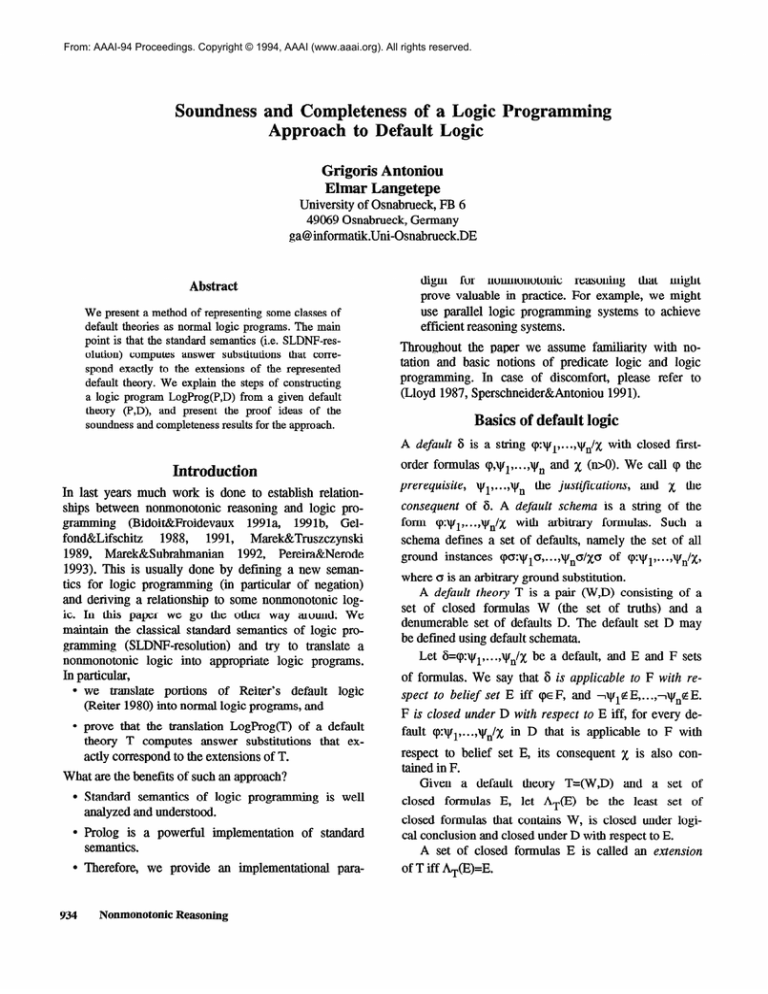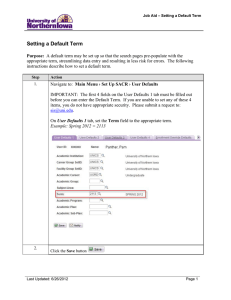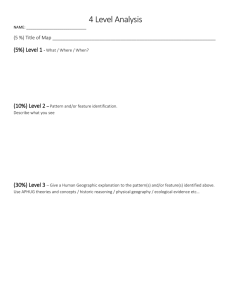
From: AAAI-94 Proceedings. Copyright © 1994, AAAI (www.aaai.org). All rights reserved.
Soundness and Completeness of a Logic Programming
Approach to Default Logic
Grigoris Antoniou
Elmar Langetepe
University of Osnabrueck, FB 6
49069 Osnabrueck, Germany
ga@informatik.Uni-Osnabrueck.DE
Abstract
We present a method of representing some classes of
default theories as normal logic programs. The main
point is that the standard semantics (i.e. SLDNF-resolution) computes answer substitutions
that correspond exactly to the extensions of the represented
default theory. We explain the steps of constructing
a logic program LogProg(P,D) from a given default
theory (P,D), and present the proof ideas of the
soundness and completeness results for the approach.
digm for nonmonotonic
reasoning that might
prove valuable in practice. For example, we might
use parallel logic programming systems to achieve
efficient reasoning systems.
Throughout the paper we assume familiarity with notation and basic notions of predicate logic and logic
programming. In case of discomfort, please refer to
(Lloyd 1987, Sperschneider&Antoniou 1991).
Basics of default logic
A default 6 is a string (p:wl,. . .,w,lx with closed ftrst-
Introduction
In last years much work is done to establish relationships between nonmonotonic reasoning and logic programming (Bidoit&Froidevaux
1991a, 199lb, Gelfond&Lifschitz
1988, 1991, Marek&Truszczynski
1989, Marek&Subrahmanian
1992, Pereira&Nerode
1993). This is usually done by defining a new semantics for logic programming (in particular of negation)
and deriving a relationship to some nonmonotonic logic. In this paper we go the other way around: We
maintain the classical standard semantics of logic programming (SLDNF-resolution) and try to translate a
nonmonotonic logic into appropriate logic programs.
In particular,
0 we translate portions of Reiter’s default logic
(Reiter 1980) into normal logic programs, and
0 prove that the translation LogProg(T) of a default
theory T computes answer substitutions that exactly correspond to the extensions of T.
What are the benefits of such an approach?
l
Standard semantics of logic programming is well
analyzed and understood.
0 Prolog is a powerful implementation of standard
semantics.
0 Therefore,
934
we provide an implementational para-
Nonmonotonic
Reasoning
order formulas (p,wl,. . .,vn and x (n>O>.We call cp the
prerequisite,
wl,...,yn
the justiJ-kations, and x the
consequent of 6. A default schema is a string of the
form <p:wl,.. .,w,lx with arbitrary formulas. Such a
schema defines a set of defaults, namely the set of all
ground instances ~po:~~o,. . .,~,cJ/xo of <p:wl,.. .,v&,
where o is an arbitrary ground substitution.
A default theory T is a pair (W,D) consisting of a
set of closed formulas W (the set of truths) and a
denumerable set of defaults D. The default set D may
be defined using default schemata.
Let 6=(p:v1,. . .,w,lx be a default, and E and F sets
of formulas. We say that 6 is applicable to F with re..,++r,@ E.
F is closed under D with respect to E iff, for every default (p:wl,. . .,w,lx in D that is applicable to F with
spect to belief set E iff <PEF, and lvlgE,.
respect to belief set E, its consequent x is also contained in F.
Given a default theory T=(W,D) and a set of
closed fOm&iS
E, let AT(E) be the least Set of
closed formulas that contains W, is closed under logical conclusion and closed under D with respect to E.
A set of closed formulas E is called an extension
of T iff h+)=E.
In (Antoniou&Langetepe 1993)] we provided an operational characterization of extensions. Here we will
show that it can be the starting point for implementational issues.
Let T=(W,D)
1. Definition
be a default theory and
II=(q-$$,li~, . . .) a finite or infinite sequence
of de-
faults from D not containing any repetitions (modelling
an application order of defaults from D). We denote
by fl[k] the initial segment of n of length k, provided
the length of n is at least k. Then . we define the following concepts:
e In(n)
is Th(M), where A4 contains the formulas of
Wand all consequents of defaults occurring in n.
0 Out(n) is the set of negations of all justifications
of defaults occurring in n.
e I1 is called a process
In(n[k])
w.r.t. belief
of T if $
is applicable to
set In(IT[k]), for
every k
such that 6k occurs in n.
0 n
is
called
a
In(n)nOut(n)=0,
process.
successful
of
T
iff
otherwise it is called a failed
e n is a closed process
applicable
process
to In(n)
Restriction 1 is clear as we plan to use standard logic
programming for deduction, while restriction 2 is
only used for the sake of convenience and simplicity. 3
and 4 are restrictive, and we are working on weakening these conditions (for example by admitting conjunction). Nevertheless, Horn default theories are
powerful enough to include say taxonomic default theories (Froidevaux 1986).
The main ideas of the translation of Horn default
theories into normal logic programs are the following:
0 Use negation as failure to model nonmonotonicity.
0 Enumerate the defaults and represent a current process II by the numbers of the defaults in II.
0 Replace negative literals lp
by new predicates p.
with respect
to belief
The logical basis of treating
negative literah
set
In(U) collects all formulas in which we believe after
application of the defaults in II, while Out.(U) consists of all those formulas which we should avoid to
believe for the sake of consistency. The following result (for a proof see (Antoniou&Sperschneider 1993))
states the relationship between default logic extensions and processes.
Let T=(W,D) be a default theory. If n is
a closed successful process of T, then In(n) is an extension of T. Conversely, for every extension E of T
there exists a closed, successful process n of T with
E=In(Il).
As negative literals may be used in defaults, we shall
have to test derivability or nonderivability of negative
literals from the knowledge base built at some stage
(i.e. the In-set of the process built so far). Consider
as a simple example the set of Horn formulas P =
{ptq, tp} ; lq obviously follows from P. If we use
new predicate symbols for negated atoms, we can
translate P into the logic program P’ = {ptq, p+}.
Unfortunately, there is no SLD-refutation of P’u {CJ}
as should be. What is obviously missing is application
of the rule p+-q via contraposition, i.e. q&p. This
gives rise to the following definition.
3. Definition
Informal outline
Our approach of representing default theories by logic
programs does not apply to arbitrary default theories,
but to a subset thereof we call Horn default theories.
The restrictions are as follows:
1. The truths of the default theories are given in
Horn logic.
2. Each default has exactly one justification.
appearing in defaults
In the next section we show how negative literals can
be treated using new predicates. Then we put all ideas
together and present the entire translation.
of T iff every 6~ D which is
In(n) already occurs in n.
2. Theorem
4. The prerequisite, justification, and consequent of
each default is a positive or negative ground literal. In this paper we further restrict attention to
propositional literals, but only to keep the following sections technically simpler.
For a de@nite logic program P define e
as {~itA,BII..
.,Bi-I,Bi+I,. . .,Bn I AtBI,.
. .,B,E P, n
21, & {1, . . .,n}}.
Usage of Pue is still insufficient as shown by the
following example. Let P be {ptq,r , q+r, tp}. Obviously, lr follows from P, but there is no SLD-refutation of PupV {tr)
= {ptq,r , qtp,r
, gtp,q ,
q+r ,3--g , +p , +-g}. Reflection on this example
shows that missing is a fact rc that is needed in the
3. The set of defaults is finite.
Nonmonotonic
Reasoning
935
SLD-refutation. This means that when testing derivability of some g from PuE we must (temporarily)
add an additional fact rt to the knowledge base. It
can be shown that this approach is sound and complete; for a proof, see (Langetepe 1994).
4. Theorem
Gl , . . .,Gk
Let P be a definite logic program,
positive
literals,
and
Pu{+G1,.
0 If the prerequisite of 6i is lp then add
p(L)tmember([pre,i],L).
The meaning gets clear if we think back to Theorem 4. There we saw that in order to test derivability of a negative literal lp (as in the test of
applicability of default Si), we must temporarily
A,
. .,tGk}
add p to the current howledge base. Exactly this
is the meaning of the added rule: we are adding p
but in a distinguished way (indicated by pre), so
that p is not part of the current knowledge base
but is only used in the derivability test of e.
consistent.
l
If the justification of pi is a positive literal q then
add
q(L)tmember([conscheck,i],L).
The logic program LogProg(P,D)
Given a Nom default theory T=(P,D), we construct a
corresponding logic program LogProg(P,D).
0. step: Enumerate
The explanation of this rule is the same as above,
if we recall that consistency check means to try to
derive the negation of the justification, in our case
lq, a negative literal.
4. step: Build program Member
D
Enumerate the (finitely many) defaults in D: Let D be
member(X, [Xl L]) t
(q),...,s,>.
member(X,[YIL])
t
member(X,L).
1. step: Build PL
5. step: The control structure Process(D)
As stated before, we use a list to represent the defaults applied so fx. This means that the consequents
of the defaults in the process built so far are available
in the knowledge base. Obviously, the truths of the
default theory (i.e. P) are available at any stage.
Therefore: For each program clause ptpl,. . .,pk in P
The function of the control structure is to systematically build processes by applying defaults and backtracking, if necessary (i.e. if a process is failed or if
another extension is sought).
Let iE (0,. . .,n} (recall that D = {so,. . .,S,}> and 6i
build the clause
be the default pi:B/C. Define 9i as g if B is a positive
atom q, and as q if B is a negative atom lq. Similarly,
define gi as g if C is a positive atom r, and as r if B is
a negative atom -r. Add to the logic program the rule
In the previous section we saw that p is necessary for
the derivation of negative literals. Equip the rules in
g with a list L as seen in the 1. step.
proc(i):
‘process(Lold,L) t
pi(KpM I LW),
3. step: Build Supplement(D)
0 For each default 6i in D with consequent r add the
clause
r(L)tmember(i,L).
For each default 6i in D with consequent lr
the clause
add
t-(L)tmember(i,L).
The meaning is what we have already stated before: If i is member of L then 6i has been applied,
so its consequent should be in the current knowledge base (determined by L).
936
Nonmonotonic
Reasoning
consistent(Lold),
not member(i,Lold),
not qi([[conscheck,i] I Lold]),
process([i I Lold],L).
Now we add some additional rules, namely the termination case for the predicate process, and the implementation of the predicates consistent, closed, and
successful.
process(L,L) t
closed(L) t
consistent(L), closed(L),
successful(L)
not ( not member(O,L),
P(J([[Pre,Ol l
LI),
not qg([[conscheck,O] I L]) ),
with ij~ {O,. . .,n}, and
...
n = (ai,,...,q,)
not ( not member(n,L),
is a closed, successful process of (P,D), i.e. Zn(lI) is
an extension of (P,D).
P,([[Pml 1LIL
not q,([[conscheck,n]
I L]) )
successful(L) t
not ( member(O,L), gO([[conscheck,O] I L]) ),
.
not ( member(n,L), q,([[iinscheck,n]
consistent([ 1) tconsistent([i I Lold]) t
(b) If P is hierarchical
and n
closed, success@1 process
an SLDNF-refitation of
],L)}
with computed answer substitution {LQ,
not Li([i I Lold]).
(the last rule, of course, for each iE {0,. . .,n}).
6. step: LogProg(P,D)
Define LogProg(P,D) as
PLu$uSupplement@)uMemberuProcess@).
Explanations and examples of this approach can be
found in (Antoniou&Langetepe 1994).
Remark on a Prolog implementation
When implementing the normal logic program LogProg(P,D) in Prolog, some obvious modifications
must be carried out. These include a more efficient implementation of member, and usage of one Prolog
rule instead of the finite collection of rules proc(i)
for the predicate process and corresponding rules in
the definition of closed and consistent. The reason
we use separate rules in LogProg(P,D) is of technical
nature in order to derive soundness and completeness;
it is easily seen that the Prolog implementation with
one rule would not lead to a normal logic program
(predicates pi and CJiwould dynamically depend on the
default i chosen).
.,6ik) is a
of (P,D), then there exists
LogProg(P,D)u{+process([
I L]) ),
= (Q..
. . .,iO]}.
The proof outline
Both soundness and completeness of our approach are
shown using the operational semantics of LogProg(P,D), i.e. by analyzing the structure of an SLDNF-refutation of LogProg(P,D)u{ tprocess([
],L)} .
Because of space limitations we only give the main
steps and lemmata of the proof.
Soundness
First we show that representing inclusion of formulas
in the current knowledge base as done in LogProg(P,D) works in the intended way.
6. Lemmu Let P be a definite logic program, pi(ti) (i
= Z ,2 ,3) ground atoms, A an atom, L’ a ground list,
and ti’ (i = 1, 2, 3) ground terms such that tl ‘&‘eL’
and t3’e L’. Assume that predicate
member does not
occur in P or in A. Then: An SLDNF-refutation of
exists #there
is an SLDNF-refutation of
PLu Member
u
{pi(ti)tmember(ti’,L’)
I i = 1, 3)
u
The main result
The ground atoms pi(ti) cover the three possible cases:
Our approach is sound and complete - the entire proof
is given in (Langetepe 1994); in the next section we
present the main steps). Note that the additional condition in the completeness result (hierarchical program P) has nothing to do with our approach, but is
the usual restriction in the completeness of SLDNFresolution.
pI(tI) is included in the knowledge base, p2(t2) and
5. Theorem
Let (P,D) be a Horn default theory.
p&)
are not: the first one because of the lacking cor-
responding rule, the latter because t3’@L’. Lemma 6
can be extended to an arbitrary finite number of
ground atoms and to arbitrary goals (in Horn logic).
The following lemma gives some structure properties
of SLDNF-refutations of LogProg(P,D)u {tprocess( [
l&N
l
(a) Zfthere exists an SLDNF-refutation of
7.
LogProg(P,D)u~tprocess([
l,L)],
then the computed answer substitution has the form
Prog(P,D)u{tprocess([
erties:
MD,.
. &I]
Lemma
An
SLDNF-refutation
of
Log-
],L)} has the following prop-
(4 There are k resolution steps with side clauses
proc(i),
and then one step with side clause with
Nonmonotonic
Reasoning
937
head process(L,L). No other rule from Process(D)
is used afterwards.
(b) Each intermediate goal G includes at most one literal with predicate process;
the literal has the
form process(L1,L2) with a ground list L, and a
variable Lz occurring only once in G.
Further analysis the
Prog(P,D)u{ tprocess([
leads to the following
8. Lemma
SLDNF-refutation
of Log],L)} using the result above
],L)}
with computed an-
(a) p = {L/[iol.. .,ik.]} with ij’ {O,. . .,n}
(b) For m = k, k-l, . . ..O there are SLDNF-refitations
of
LogProg(P,D)u{t
not lik-m(]ik-m,. . ., iO]]
LogProg(P,D)u{t
not member(ik_,,[ik-,-l,...,iO]}
not ~lk-m(~~conschec~ik_mll~ik_m_l~.. -dollh
(c) For each ie {O,. . ., n} exists a Jinitely failed SLDNFtree of
LogProg(P,D)u{t
not member(i&,.
LogProg(P,D)u{t
pi([ ]pre,i]&k, . . .,io]
. .,io]} or of
11OrOf
not @[conscheck,i]&,
. . .,iol]}.
iE {O,..., n} exists a finitely failed SLD-
LogProg(P,D)u{tmember(i,[i~.
. .,id} or of
closed, successful process II of (P,D). This shows
that the computed answer substitution rvri,...&]]
determines the generating defaults of the extension
In(II) of (P,D).
Completeness
Let P be a hierarchical
logic program.
Then, Pue is also hierarchical.
Proof scetch
Let m := max{ level(p) I p predicate symbol in P} . Define
938
Nonmonotonic
lqikmm
l
PU{l&lS
l
Pu{ris I s = 0,. . .,k-m-l } is consistent.
Applying the results of Theorem 4, completeness of
SLDNF-resolution
for hierarchical programs, and
Lemma 6 we can show existence of
an SLDNF-derivation of tprocess( [ik,. . . ,io],L)
],L)}
(*I
From the information that P is closed and successful
we may show that there exist SLDNF-refutations of
(**I
LogProg(P,D)u{ +consistent([ik,. . . ,id> >
Resolving
tprocess([ik,.
. .,b],L)
(from
(*))
with
side clause
process(L’,L’) t
consistent&‘), closed(L’),
successful(L’)
using a most general unifier {L&k,.. .,i& L’/[ik,. .&]}
and applying (**) we finally derive the empty clause.
Altogether, we have constructed an SLDNF-refutation of LogProg(P,D)u{ +process([ ],L)} with computed answer substitution {L/[ik,. . .,$J }.
%([[conscheck, i/I&, . . ., io]]}.
Using this lemma and soundness of SLDNF-resolution it is not difficult to show that indeed defaults
6.ik, . . .,5io may be applied in this order and form a
9. Lemma
= 0,. . .,k-m-l} k
pikmm
LO@Og(P,D)U
LogProg(P,D)u
LogProg(P,D)u{+
0
{ tClOSCd(
[ik,. . . ,io]) }
LogProg(P,D)u {tsuccessful([ik,. . .,i($)>
bkwm-1)--.)iO111
k- J&-m+1 ([ @repikmml’
(d) For each
NF-tree of
* i ,. . .,ik are pairwise disjoint
fiorn LogProg(P,D)u{ tprocess([
LogProg(P,D)u
LogProg(P,D)u{t
successful process of (P,D) (i.e. In(II) is an extension
of the default theory (P,D) ). By definition of processes wehaveforallm=k,
k-l,...,1
of
swer substitution CL.Then:
/+
With this definition it is easy to check that Pup is hierarchical. NOW suppose II = (si,,. . .,si,) is a COOS&,
* pV{ri, I s = 0 ,..., k-m-l} b
Suppose there is an SLDNF-refutation
LogProg(P,D)u{+process([
level(Q) := 2m - level(p) + 1.
Reasoning
Conclusion
We gave an automated translation of a class of default
theories into normal logic programs. The main contribution of this paper is the proof (outline) of the result that the answer substitutions computed by the
logic program via its standard semantics correspond
exactly to the extensions of the default theory.
There is still much work to be done. First, we are
working on weakening some restrictions to the default theories. We are thinking especially of admitting conjunction and investigating cases where infinite
theories and extensions could be treated (using unification).
We are also planning to make an experimental
comparison with other methods of implementing default logic like truth maintenance systems, graphs,
the system Theorist (Poole 1988) etc. One of the
most promising ideas is to exploit the parallelism in
the logic programs given in this paper and thus in providing an efficient, parallel implementation of (parts
of) default logic.
Finally, we are planning to investigate the relevance of our translation of default theories into logic
programming when using nonstandard semantics.
References
Antoniou, G., and Sperschneider, V. 1993. Computing
Extensions of Nonmonotonic Logics. In Proceedings
4th Scandinavian Conference on Artificial Intelligence, 10s Press.
Antoniou, G., and Langetepe, E. 1993. A Process
Model for Default Logic and its realization in Logic
Programming. In Proceedings Portuguese Conference
on Artificial Intelligence (APIA-93), Springer LNAI.
Antoniou, G., and Langetepe, E. 1994. Translation of
parts of default logic into normal logic programs
with standard semantics. In Proceedings European
Conference on Artificial Intelligence (submitted).
Gelfond, M., and Lifschitz, V. 1988. The Stable Model Semantics for Logic Programming. In Proceedings
5th Int. Conference/Symposium on Logic Programming, 1070- 1080.
Gelfond, M., and Lifschitz, V. 1991. Classical Negation in Logic Programs and Disjunctive Databases.
New Generation Computing 9,365385.
Langetepe, E. 1994. Betrachtung einzelner DefaultLogik Ansatze unter Verwendung eines operationalen
Extensionsmodells. Masters Thesis, Fachbereich 6,
Universitat Osnabrtick.
Lloyd, J.W. 1987. Foundations of Logic Programming
2. edition. Springer.
Marek, W., and Truszczynski, M. 1989. Stable Semantics for Logic Programs and Default Theories. In Proceedings
North American Conference on Logic
Programming, 243-256.
Marek, W., and Subrahmanian, V.S. 1992. The Relationship between Stable, Supported, Default and Autoepistemic Semantics for General Logic Programs.
Theoretical Computer Science 103,365386.
Pereira, L.M., and Nerode, A. 1993. Logic Programming and Non-monotonic Reasoning, Proceedings of
the 2nd Znternational Workshop. MIT Press.
Bidoit, N., and Froidevaux, C. 1991a. General Logic
Databases and Programs: Default Logic Semantics and
Stratification. Information and Computation 91, 15-54.
Poole, D. 1988. A Logical Framework
Reasoning. Art@cial Intelligence 36.
Bidoit, N., and Froidevaux, C. 1991b. Negation by Default and Unstratifiable Logic programs. Theoretical
ficial Intelligence 13.
Computer Science 78,85- 112.
Froidevaux, C. 1986. Taxonomic Default Theory. In
Proceedings European Conference on Artificial Intelligence( ECAI-86).
for Default
Reiter, R. 1980. A Logic for Default Reasoning. ArtiSperschneider, V., and Antoniou, G. 1991. Logic: A
Foundation for Computer Science. Addison-Wesley.
Nonmonotonic
Reasoning
939



